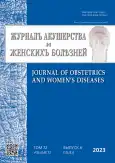Impact of surgical treatment of endometriomas on ovarian reserve and reproductive outcomes
- Authors: Molotkov A.S.1, Yarmolinskaya M.I.1, Tsypurdeeva A.A.1
-
Affiliations:
- The Research Institute of Obstetrics, Gynecology and Reproductology named after D.O. Ott
- Issue: Vol 72, No 6 (2023)
- Pages: 89-96
- Section: Original study articles
- Submitted: 25.10.2023
- Accepted: 03.11.2023
- Published: 15.12.2023
- URL: https://journals.eco-vector.com/jowd/article/view/617355
- DOI: https://doi.org/10.17816/JOWD617355
- ID: 617355
Cite item
Abstract
BACKGROUND: Endometriomas are most common during the reproductive years and have an extremely negative impact on ovarian reserve and fertility. In this case, the main method of treatment remains surgery, which inevitably injures healthy ovarian tissue. Assessing the impact of surgical treatment of endometriomas on ovarian reserve and fertility will help to optimize the management of patients of reproductive age with endometrioid cysts.
AIM: The aim of this study was to evaluate the effect of surgical treatment on ovarian reserve and reproductive outcomes in patients with endometrioid cysts.
MATERIALS AND METHODS: We analyzed the course of the disease in 289 patients with endometriomas. All patients underwent processing of medical histories and surgical protocols; then, 134 patients were surveyed in the long-term postoperative period (12–24 months after surgery) to gather data on complaints and age of the patients, the size of endometriomas, previous treatment, anti-Müllerian hormone level, and features of reproductive function implementation.
RESULTS: Among patients who had pain before surgery, 52.8% of patients noted a complete absence of pain after surgery; in 26.4% of patients, pain significantly decreased. In 65.8% of patients who had dysmenorrhea before surgery, menstruation became painless. Among patients who complained of dyspareunia before surgical treatment, in 80% of patients, pain during sexual intercourse decreased or disappeared after surgery. After surgical treatment, 119 of 134 surveyed patients (88.8%) received drugs for hormonal therapy for endometriosis. After treatment, pregnancy occurred in 54 out of 82 patients interested in reproductive function. The average anti-Müllerian hormone level before treatment was 3.8 ± 1.8 ng/ml in the age group of 20–34 years and 1.9 ± 1.5 ng/ml in the age group of 35–45 years old; after treatment, 2.7 ± 2.0 ng/ml and 1.0 ± 1.8 ng/ml, respectively.
CONCLUSIONS: Determining anti-Müllerian hormone level is one of the main methods for obtaining an idea of the patient’s ovarian reserve. At a young age and with not implemented reproductive function, it is mandatory to determine the ovarian reserve and consult a reproductive specialist before starting treatment. According to our results, surgical treatment of endometriomas is the most promising for overcoming infertility in young patients with endometriosis.
Full Text
About the authors
Arsenii S. Molotkov
The Research Institute of Obstetrics, Gynecology and Reproductology named after D.O. Ott
Author for correspondence.
Email: arseny.molotkov@gmail.com
ORCID iD: 0000-0003-3433-3092
SPIN-code: 6359-6472
MD, Cand. Sci. (Med.), Assistant Professor
Russian Federation, Saint PetersburgMaria I. Yarmolinskaya
The Research Institute of Obstetrics, Gynecology and Reproductology named after D.O. Ott
Email: m.yarmolinskaya@gmail.com
ORCID iD: 0000-0002-6551-4147
SPIN-code: 3686-3605
MD, Dr. Sci. (Med.), Professor of the Russian Academy of Sciences
Russian Federation, Saint PetersburgAnna A. Tsypurdeeva
The Research Institute of Obstetrics, Gynecology and Reproductology named after D.O. Ott
Email: tsypurdeevan@mail.ru
ORCID iD: 0000-0001-7774-2094
SPIN-code: 5208-9707
MD, Cand. Sci. (Med.), Assistant Professor
Russian Federation, Saint PetersburgReferences
- Busacca M, Vignali M. Ovarian endometriosis: from pathogenesis to surgical treatment. Curr Opin Obstet Gynecol. 2003;15(4):321–326. doi: 10.1097/01.gco.0000084247.09900.4f
- Daniilidis A, Grigoriadis G, Kalaitzopoulos DR, et al. Surgical management of ovarian endometrioma: impact on ovarian reserve parameters and reproductive outcomes. J Clin Med. 2023;12(16):5324. doi: 10.3390/jcm12165324
- As-Sanie S, Black R, Giudice LC, et al. Assessing research gaps and unmet needs in endometriosis. Am J Obstet Gynecol. 2019;221(2):86–94. doi: 10.1016/j.ajog.2019.02.033
- Ballweg ML. Big picture of endometriosis helps provide guidance on approach to teens: comparative historical data show endo starting younger, is more severe. J Pediatr Adolesc Gynecol. 2003;16(3):S21–S26. doi: 10.1016/s1083-3188(03)00063-9
- Ballard K, Lowton K, Wright J. What’s the delay? A qualitative study of women’s experiences of reaching a diagnosis of endometriosis. Fertil Steril. 2006;86(5):1296–1301. doi: 10.1016/j.fertnstert.2006.04.054
- Rossiyskoe obshchestvo akusherov-ginekologov (ROAG). Endometrioz. Klinicheskie rekomendatsii. 2020. (In Russ.) [cited 2023 Oct 20]. Available from: https://roag-portal.ru/recommendations_gynecology
- Mechsner S. Endometriosis, an ongoing pain-step-by-step treatment. J Clin Med. 2022;11(2):467. doi: 10.3390/jcm11020467
- Guo SW. Recurrence of endometriosis and its control. Hum Reprod Update. 2009;15(4):441–461. doi: 10.1093/humupd/dmp007
- Kasapoglu I, Ata B, Uyaniklar O, et al. Endometrioma-related reduction in ovarian reserve (ERROR): a prospective longitudinal study. Fertil Steril. 2018;110(1):122–127. doi: 10.1016/j.fertnstert.2018.03.015
- Streuli I, de Ziegler D, Gayet V, et al. In women with endometriosis anti-Müllerian hormone levels are decreased only in those with previous endometrioma surgery. Hum Reprod. 2012;27(11):3294–3303. doi: 10.1093/humrep/des274
- Muzii L, Di Tucci C, Di Feliciantonio M, et al. Antimüllerian hormone is reduced in the presence of ovarian endometriomas: a systematic review and meta-analysis. Fertil Steril. 2018;110(5):932–940.e1. doi: 10.1016/j.fertnstert.2018.06.025
- Raffi F, Metwally M, Amer S. The impact of excision of ovarian endometrioma on ovarian reserve: a systematic review and meta-analysis. J Clin Endocrinol Metab. 2012;97(9):3146–3154. doi: 10.1210/jc.2012-1558
Supplementary files






